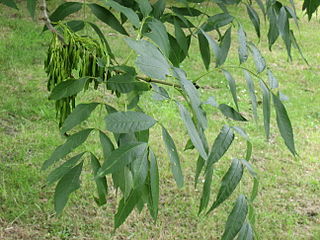
Fraxinus, commonly called ash, is a genus of plants in the olive and lilac family, Oleaceae, and comprises 45–65 species of usually medium-to-large trees, most of which are deciduous trees, although some subtropical species are evergreen trees. The genus is widespread throughout much of Europe, Asia, and North America.

Fraxinus excelsior, known as the ash, or European ash or common ash to distinguish it from other types of ash, is a flowering plant species in the olive family Oleaceae. It is native throughout mainland Europe east to the Caucasus and Alborz mountains, and Great Britain and Ireland, the latter determining its western boundary. The northernmost location is in the Trondheimsfjord region of Norway. The species is widely cultivated and reportedly naturalised in New Zealand and in scattered locales in the United States and Canada.

Mercurialis perennis, commonly known as dog's mercury, is a poisonous woodland plant found in much of Europe as well as in Algeria, Iran, Turkey, and the Caucasus, but almost absent from Ireland, Orkney and Shetland. A member of the spurge family (Euphorbiaceae), it is a herbaceous, downy perennial with erect stems bearing simple, serrate leaves. The dioecious inflorescences are green, bearing inconspicuous flowers from February to April. It characteristically forms dense, extensive carpets on the floor of woodlands and beneath hedgerows.

Fraxinus pennsylvanica, the green ash or red ash, is a species of ash native to eastern and central North America, from Nova Scotia west to southeastern Alberta and eastern Colorado, south to northern Florida, and southwest to Oklahoma and eastern Texas. It has spread and become naturalized in much of the western United States and also in Europe from Spain to Russia.
The Idaho State Arboretum is an arboretum located across the campus of the Idaho State University, Pocatello, Idaho, United States. It is open to the public daily without charge and includes an organized tree walk.

Fraxinus oxycarpa 'Raywood' known as the claret ash or Raywood ash is a cultivar of ash tree, a seedling variant of the Caucasian ash.

Fraxinus angustifolia, the narrow-leaved ash, is a species of Fraxinus native to Central Europe and Southern Europe, Northwest Africa, and Southwest Asia.

Fraxinus ornus, the manna ash or South European flowering ash, is a species of Fraxinus native to Southern Europe and Southwestern Asia, from Spain and Italy north to Austria and the Czech Republic, and east through the Balkans, Turkey, and western Syria to Lebanon and Armenia.

Fraxinus mandshurica, the Manchurian ash, is a species of Fraxinus native to northeastern Asia in northern China, Korea, Japan and southeastern Russia.

Tetrops is a small genus of longhorn beetles found in Eurasia. One species, Tetrops praeustus, has recently been introduced in Eastern North America.

Pluteus americanus is a North American and Russian psychedelic mushroom that grows on hardwoods.

Paraglenea fortunei is a species of beetle in the family Cerambycidae. It was described by Saunders in 1853, originally under the genus Glenea. It is known from Taiwan, China, North Korea, South Korea, and Vietnam, and has been introduced into Japan. It feeds on Cinnamomum camphora, Boehmeria nivea, Hibiscus syriacus, Morus alba, and Triadica sebifera.

Phytoecia puncticollis is a species of beetle in the family Cerambycidae. It was described by Faldermann in 1837. It is known from Russia, Azerbaijan, Georgia, Iraq, Armenia, Turkey, Iran, and Turkmenistan. It feeds on Eryngium billardierei.
Tetrops formosus is a species of beetle in the family Cerambycidae. It was described by Baeckmann in 1903. It is known from Kazakhstan, China, and Kyrgyzstan.

Fraxinus uhdei, commonly known as tropical ash or Shamel ash, is a species of tree native to Mexico and Central America. It is commonly planted as a street tree in Mexico and the southwestern United States. It has also been planted and spread from cultivation in Hawaii, where it is now considered an invasive species.

Phlyctis argena is a species of crustose lichen.
Fraxinus greggii, the littleleaf ash or Gregg's ash, is a species of flowering plant in the family Oleaceae, native to Texas and Mexico. A xerophytic shrub or scrubby tree reaching 6 m (20 ft), it is suitable for screens and containers. There is a cultivar, 'Libby Davison'.














